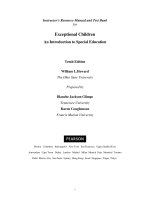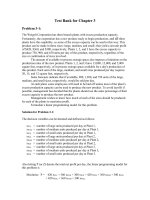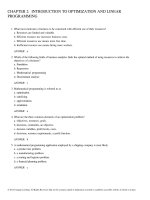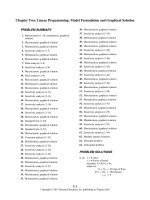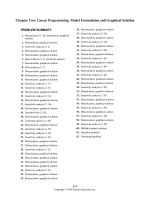Introduction to social problems 10th edition by sullivan test bank
Bạn đang xem bản rút gọn của tài liệu. Xem và tải ngay bản đầy đủ của tài liệu tại đây (267.67 KB, 17 trang )
Introduction to Social Problems 10th edition by Thomas J. Sullivan Test Bank
Link full download test bank: />Link full download solution manual: />
Chapter 02 – Concentration of Power: Economic and Political Institutions
Multiple Choice Questions
1. The economies of most nations today are
a. market economies
b. planned economies
c. command economies
d. traditional economies
.
Answer: a
Question Title: TB_02_01 Types of Economic Systems, Remember, LO 2.1
Learning Objective: 2.1 Describe and compare capitalist, socialist, and mixed economies.
Topic: Types of Economic Systems
Skill Level: Remember the Facts
Difficulty: 1–Easy
2. In the country of Zuri, all industries and institutions of economic production are privately
owned. With free competition among producers and consumers, profit-making is the main target.
Which of the following types of economies is prevalent in Zuri?
a. command economy
b. mixed economy
c. socialist economy
d. capitalist economy
Answer: d
Question Title: TB_02_02 Types of Economic Systems, Apply, LO 2.1
Learning Objective: 2.1 Describe and compare capitalist, socialist, and mixed economies.
Topic: Types of Economic Systems
Skill Level: Apply What You Know
Difficulty: 2–Moderate
3. In a capitalist economy, the government is prohibited from
a. framing policies to maintain public order
b. deciding the prices of goods and wages of laborers
c. protecting companies against foreign threats
d. allowing market forces to operate unhindered
.
17
Copyright ©2016 Pearson Education, Inc. All rights reserved.
Answer: b
Question Title: TB_02_03 Types of Economic Systems, Remember, LO 2.1
Learning Objective: 2.1 Describe and compare capitalist, socialist, and mixed economies.
Topic: Types of Economic Systems
Skill Level: Remember the Facts
Difficulty: 1–Easy
4. In capitalism, the production of goods is based on
a. government orders
b. power concentration
c. economic demand
d. collective goals
.
Answer: c
Question Title: TB_02_04 Types of Economic Systems, Remember, LO 2.1
Learning Objective: 2.1 Describe and compare capitalist, socialist, and mixed economies.
Topic: Types of Economic Systems
Skill Level: Remember the Facts
Difficulty: 1–Easy
5. The country of Renada follows capitalism. Which of the following problems is it most likely
to face due to its economic system?
a. exploitation of workers by factory owners to increase their own profits
b. the absence of a variety of quality products for consumers to choose from
c. losses incurred by private owners due to the greater role played by the government in making
economic decisions
d. the inability of manufacturers to meet specific customer needs due to the pressure to achieve
collective goals
Answer: a
Question Title: TB_02_05 Types of Economic Systems, Analyze, LO 2.1
Learning Objective: 2.1 Describe and compare capitalist, socialist, and mixed economies.
Topic: Types of Economic Systems
Skill Level: Analyze It
Difficulty: 3–Difficult
6. Which of the following is true of a socialist economy?
18
Copyright ©2016 Pearson Education, Inc. All rights reserved.
a. Goods and services are provided if people can afford to purchase them.
b. The primary motivation for economic activity is to achieve profits.
c. Decisions on what to produce and how to distribute products are made only by private owners.
d. The primary motivation for economic activity is to achieve collective goals.
Answer: d
Question Title: TB_02_06 Types of Economic Systems, Understand, LO 2.1
Learning Objective: 2.1 Describe and compare capitalist, socialist, and mixed economies.
Topic: Types of Economic Systems
Skill Level: Understand the Concepts
Difficulty: 2–Moderate
7. Which of the following is the difference between a capitalist economy and a socialist
economy?
a. A capitalist economy is characterized by production based on economic demand, whereas a
socialist economy is characterized by production based on human demand.
b. A pure capitalist economy is very rare, whereas a pure socialist economy is followed in most
of the countries today.
c. A capitalist economy is primarily motivated to achieve collective goals, whereas a socialist
economy is motivated to make higher profits.
d. A capitalist economy allows greater government intervention in deciding on economic
activities, whereas a socialist economy restricts government intervention in such activities.
Answer: a
Question Title: TB_02_07 Types of Economic Systems, Analyze, LO 2.1
Learning Objective: 2.1 Describe and compare capitalist, socialist, and mixed economies.
Topic: Types of Economic Systems
Skill Level: Analyze It
Difficulty: 3–Difficult
8. A
is a business enterprise that is owned by stockholders, most of whom are not
involved in running the daily affairs of the business.
a. proprietorship
b. corporation
c. law firm
d. social institution
Answer: b
19
Copyright ©2016 Pearson Education, Inc. All rights reserved.
Question Title: TB_02_8 The Concentration of Economic and Political Power, Remember, LO
2.2
Learning Objective: 2.2 Characterize the ways in which economic and political power have
become concentrated in modern economies.
Topic: The Concentration of Economic and Political Power
Skill Level: Remember the Facts
Difficulty: 1–Easy
9. A form of restrictive growth in the marketplace in which one company controls a product or
service is known as
.
a. oligopsony
b. monopoly
c. monopsony
d. duopoly
Answer: b
Question Title: TB_02_09 The Concentration of Economic and Political Power, Remember, LO
2.2
Learning Objective: 2.2 Characterize the ways in which economic and political power have
become concentrated in modern economies.
Topic: The Concentration of Economic and Political Power
Skill Level: Remember the Facts
Difficulty: 1–Easy
10. An oligopoly is different from a monopoly in that an oligopoly is characterized by the
.
a. control of a market by few companies
b. multinational nature of the companies involved
c. complete domination of some markets by a company
d. control of a market by a conglomerate
Answer: a
Question Title: TB_02_10 The Concentration of Economic and Political Power, Analyze, LO 2.2
Learning Objective: 2.2 Characterize the ways in which economic and political power have
become concentrated in modern economies.
Topic: The Concentration of Economic and Political Power
Skill Level: Analyze It
20
Copyright ©2016 Pearson Education, Inc. All rights reserved.
Difficulty: 3–Difficult
11. A(n)
is a corporation that owns other companies in fields quite different from that
of the parent company.
a. anomie
b. in-group
c. monopsony
d. conglomerate
Answer: d
Question Title: TB_02_11 The Concentration of Economic and Political Power, Remember, LO
2.2
Learning Objective: 2.2 Characterize the ways in which economic and political power have
become concentrated in modern economies.
Topic: The Concentration of Economic and Political Power
Skill Level: Remember the Facts
Difficulty: 1–Easy
12. Which of the following responsibilities was given to the central government of the United
States during the formation of the new Constitution post independence?
a. raising an army
b. regulating banks
c. providing healthcare facilities to its citizens
d. overseeing the allocation of resources
Answer: a
Question Title: TB_02_12 The Concentration of Economic and Political Power, Remember, LO
2.2
Learning Objective: 2.2 Characterize the ways in which economic and political power have
become concentrated in modern economies.
Topic: The Concentration of Economic and Political Power
Skill Level: Remember the Facts
Difficulty: 1–Easy
13. Which of the following ideas is emphasized by the functionalist perspective?
a. A conflict of interests and maldistribution of resources is necessary to maintain a normal state
of affairs in a society.
21
Copyright ©2016 Pearson Education, Inc. All rights reserved.
b. Concentration of power and resources in the hands of a few should be encouraged so that only
a few people have the authority over others.
c. The various interrelated parts of a society should be sufficiently integrated so that people can
use them to work together toward common goals.
d. Collective action by oppressed groups can lead to the elimination of inequalities in power and
rearrangement of resources.
Answer: c
Question Title: TB_02_13 Perspectives on the Concentration of Power, Understand, LO 2.3
Learning Objective: 2.3 Summarize what the sociological perspectives say about issues of
concentration of economic and political power; explain the power elite and pluralist perspectives
on this and assess the evidence for each.
Topic: Perspectives on the Concentration of Power
Skill Level: Understand the Concepts
Difficulty: 2–Moderate
14. Cultural values in the United States place emphasis on
a. the importance of democratic decision making
b. government rights to control the destiny of the people
c. collectivistic and public ownership of properties
d. the importance of unequal concentration of power and wealth
.
Answer: a
Question Title: TB_02_14 Perspectives on the Concentration of Power, Remember, LO 2.3
Learning Objective: 2.3 Summarize what the sociological perspectives say about issues of
concentration of economic and political power; explain the power elite and pluralist perspectives
on this and assess the evidence for each.
Topic: Perspectives on the Concentration of Power
Skill Level: Remember the Facts
Difficulty: 1–Easy
15. Amy is a conflict theorist. She is most likely to describe a society to be
.
a. made up of many interrelated and interdependent elements
b. made of a variety of different interest groups that compete with one another over the resources
available
c. characterized by day-to-day interactions between people who use symbols to understand the
meaning of these interactions
22
Copyright ©2016 Pearson Education, Inc. All rights reserved.
d. characterized by maldistribution of resources and power that can be eliminated by collective
action
Answer: b
Question Title: TB_02_15 Perspectives on the Concentration of Power, Analyze, LO 2.3
Learning Objective: 2.3 Summarize what the sociological perspectives say about issues of
concentration of economic and political power; explain the power elite and pluralist perspectives
on this and assess the evidence for each.
Topic: Perspectives on the Concentration of Power
Skill Level: Analyze It
Difficulty: 3–Difficult
16. Which of the following models or theories has been developed to assess how decision
making actually is in the United States?
a. the Zelinsky model
b. the post-development theory
c. the power elite model
d. the institutional theory
Answer: c
Question Title: TB_02_16 Perspectives on the Concentration of Power, Remember, LO 2.3
Learning Objective: 2.3 Summarize what the sociological perspectives say about issues of
concentration of economic and political power; explain the power elite and pluralist perspectives
on this and assess the evidence for each.
Topic: Perspectives on the Concentration of Power
Skill Level: Remember the Facts
Difficulty: 1–Easy
17. According to the power elite model, who among the following is most likely to become a
member of the power elite group?
a. Kiara, who owns a very large and successful corporation
b. Dave, who is a lobbyist
c. Angelo, who is a college student with the right to vote
d. Sally, who is an employee at a software firm
Answer: a
23
Copyright ©2016 Pearson Education, Inc. All rights reserved.
Question Title: TB_02_17 Perspectives on the Concentration of Power, Apply, LO 2.3
Learning Objective: 2.3 Summarize what the sociological perspectives say about issues of
concentration of economic and political power; explain the power elite and pluralist perspectives
on this and assess the evidence for each.
Topic: Perspectives on the Concentration of Power
Skill Level: Apply What You Know
Difficulty: 2–Moderate
18. Which of the following ideas is expressed in the power elite model?
a. The middle level in the political structure of the U.S. consists of the great mass of citizens who
have the power to elect the elite members.
b. The elite do not have the power to determine which candidates political parties will place
before the electorate.
c. The members of the power elite group maintain a consensus about their interests through their
elaborate social networks.
d. There are veto groups in society with the ability to block decisions that might adversely affect
their positions.
Answer: c
Question Title: TB_02_18 Perspectives on the Concentration of Power, Understand, LO 2.3
Learning Objective: 2.3 Summarize what the sociological perspectives say about issues of
concentration of economic and political power; explain the power elite and pluralist perspectives
on this and assess the evidence for each.
Topic: Perspectives on the Concentration of Power
Skill Level: Understand the Concepts
Difficulty: 2–Moderate
19. The
refers to the relationship between the armed forces that want to purchase
weapons and the corporations that produce the weapons.
a. pluralist model
b. military–industrial complex
c. world-system theory
d. medical–industrial complex
Answer: b
Question Title: TB_02_19 Perspectives on the Concentration of Power, Remember, LO 2.3
24
Copyright ©2016 Pearson Education, Inc. All rights reserved.
Learning Objective: 2.3 Summarize what the sociological perspectives say about issues of
concentration of economic and political power; explain the power elite and pluralist perspectives
on this and assess the evidence for each.
Topic: Perspectives on the Concentration of Power
Skill Level: Remember the Facts
Difficulty: 1–Easy
20. According to the world-system theory, which of the following characteristics of capitalism
has led to the emergence of an international stratification system?
a. its emphasis on the achievement of collective goals
b. its ability to create a highly centralized structure for decisions regarding production and
distribution
c. its principle of producing goods based on people’s needs rather than their purchasing ability
d. its drive to expand and find new markets
Answer: d
Question Title: TB_02_20 Perspectives on the Concentration of Power, Understand, LO 2.3
Learning Objective: 2.3 Summarize what the sociological perspectives say about issues of
concentration of economic and political power; explain the power elite and pluralist perspectives
on this and assess the evidence for each.
Topic: Perspectives on the Concentration of Power
Skill Level: Understand the Concepts
Difficulty: 2–Moderate
21. The country of Ohana is a highly developed and technologically advanced country.
Corporations in this country constantly search for other less-developed countries that can provide
cheaper labor and can serve as sources of raw materials. Ohana is a
.
a. peripheral nation
b. third-world country
c. semi-peripheral nation
d. core nation
Answer: d
Question Title: TB_02_21 Perspectives on the Concentration of Power, Apply, LO 2.3
Learning Objective: 2.3 Summarize what the sociological perspectives say about issues of
concentration of economic and political power; explain the power elite and pluralist perspectives
on this and assess the evidence for each.
Topic: Perspectives on the Concentration of Power
25
Copyright ©2016 Pearson Education, Inc. All rights reserved.
Skill Level: Apply What You Know
Difficulty: 2–Moderate
22. According to historical records, what changes have been observed across countries due to
world capitalism?
a. The inequitable distribution of wealth and power around the world persists.
b. The divide between the rich and poor nations has decreased.
c. The exploitation of less powerful people by the elite in core nations has reduced.
d. The increased trade and investment produced by globalization has benefited all groups of
people equally.
Answer: a
Question Title: TB_02_22 Perspectives on the Concentration of Power, Remember, LO 2.3
Learning Objective: 2.3 Summarize what the sociological perspectives say about issues of
concentration of economic and political power; explain the power elite and pluralist perspectives
on this and assess the evidence for each.
Topic: Perspectives on the Concentration of Power
Skill Level: Remember the Facts
Difficulty: 1–Easy
23. The policies of organizations such as the World Bank and the International Monetary Fund
have been criticized because they
.
a. do not permit policies that are likely to exacerbate economic inequality and ethnic tensions
b. give greater importance to environmental conservation
c. have led to the displacement of tens of thousands of poor people, often to less desirable areas
d. can be easily manipulated by the governments of individual countries to suit their needs
Answer: c
Question Title: TB_02_23 Perspectives on the Concentration of Power, Understand, LO 2.4
Learning Objective: 2.4 Summarize the six problems that can be created by the concentration of
power in economic and political institutions.)
Topic: Problems Created by the Concentration of Power
Skill Level: Understand the Concepts
Difficulty: 1–Easy
24. In large corporations, what is the effect of the power concentration on worker unions?
a. It has empowered unions to represent workers’ issues.
b. It has reduced the extent to which unions can push their demands.
26
Copyright ©2016 Pearson Education, Inc. All rights reserved.
c. It has given unions power to decide the wages of workers.
d. It has led to the enactment of policies that ban the formation of unions.
Answer: b
Question Title: TB_02_24 Problems Created by the Concentration of Power, Understand, LO 2.4
Learning Objective: 2.4 Summarize the six problems that can be created by the concentration of
power in economic and political institutions.
Topic: Problems Created by the Concentration of Power
Skill Level: Understand the Concepts
Difficulty: 1–Easy
25. One of the problems resulting from massive governments is that they _
.
a. restrict the ability of isolated bureaucrats to make decisions that benefit themselves
b. give excess power to the private sector that results in the maldistribution of resources
c. distance individuals from those who actually make economic and political decisions
d. become more liable to be controlled by the general public
Answer: c
Question Title: TB_02_25 Problems Created by the Concentration of Power, Understand, LO 2.4
Learning Objective: 2.4 Summarize the six problems that can be created by the concentration of
power in economic and political institutions.
Topic: Problems Created by the Concentration of Power
Skill Level: Understand the Concepts
Difficulty: 2–Moderate
26. Which of the following government activities has the lowest share in the total budget of the
United States?
a. defense disbursement
b. social security programs
c. social insurance programs for the elderly
d. public assistance
Answer: d
Question Title: TB_02_26 Future Prospects, Remember, LO 2.5
Learning Objective: 2.5 Describe and evaluate the five policy directions that have been
considered or implemented to deal with these issues.
Topic: Future Prospects
27
Copyright ©2016 Pearson Education, Inc. All rights reserved.
Skill Level: Remember the Facts
Difficulty: 1–Easy
27. Which of the following measures will help regulate governments more closely and
efficiently?
a. reducing the number of agencies that do the regulating to reduce inefficiency in monitoring
b. increasing protections and rewards for internal auditors in government agencies
c. firing bureaucrats in government agencies who are whistle-blowers
d. avoiding public disclosure of information that could be detrimental to those heading
government agencies
Answer: b
Question Title: TB_02_27 Future Prospects, Understand, LO 2.5
Learning Objective: 2.5 Describe and evaluate the five policy directions that have been
considered or implemented to deal with these issues.
Topic: Future Prospects
Skill Level: Understand the Concepts
Difficulty: 2–Moderate
28. Fight for Animals is an interest group started by a group of college students. This group
focuses on reducing the ill-treatment of animals and tries to find families that are willing to adopt
strays or abandoned pets. The group uses the resources available for its various advertising and
campaigning activities. Fight for Animals is an example of a
.
a. total institution
b. nongovernmental organization
c. booster club
d. professional association
Answer: b
Question Title: TB_02_28 Future Prospects, Apply, LO 2.5
Learning Objective: 2.5 Describe and evaluate the five policy directions that have been
considered or implemented to deal with these issues.
Topic: Future Prospects
Skill Level: Apply What You Know
Difficulty: 2–Moderate
29.
involves an attempt to provide laborers with management authority and
responsibility and more control over the operation of corporations.
28
Copyright ©2016 Pearson Education, Inc. All rights reserved.
a. Capitalism
b. Worker empowerment
c. World-system theory
d. Industrialization
Answer: b
Question Title: TB_02_29 Future Prospects, Remember, LO 2.5
Learning Objective: 2.5 Describe and evaluate the five policy directions that have been
considered or implemented to deal with these issues.
Topic: Future Prospects
Skill Level: Remember the Facts
Difficulty: 1–Easy
30. Which of the following ideas has been expressed by proponents of an extreme power elite
position with the intention of reducing the concentration of power and resources in societies?
a. Capitalism can be modified to work for the benefit of all people irrespective of their power.
b. The avarice inherent in capitalism can be reduced by injecting an element of the public good
into economic activities and decisions.
c. Some form of mixed economy can be established to ensure that capitalism is possible in an
economy characterized by equal sharing of wealth and power.
d. A society based on capitalism can benefit only the powerful.
Answer: b
Question Title: TB_02_30 Future Prospects, Understand, LO 2.5
Learning Objective: 2.5 Describe and evaluate the five policy directions that have been
considered or implemented to deal with these issues.
Topic: Future Prospects
Skill Level: Understand the Concepts
Difficulty: 2–Moderate
Short Answer Questions
31. What measures have been taken by employers in the recent years to oppose unionization?
Answer: The opposition of employers to unionization has increased in the past few decades. It is
supported by a phalanx of consulting organizations who specialize in helping employers fight
unionization efforts. In their fight to keep unions out of the workplace, employers have
29
Copyright ©2016 Pearson Education, Inc. All rights reserved.
sometimes resorted to various forms of intimidation: Union activists are fired, companies
threaten to move jobs overseas, and employers engage in lengthy and expensive litigation to
keep unions from organizing.
Question Title: TB_02_31 The Concentration of Economic and Political Power, Remember, LO
2.2
Learning Objective: 2.2 Characterize the ways in which economic and political power have
become concentrated in modern economies.
Topic: The Concentration of Economic and Political Power
Skill Level: Remember the Facts
Difficulty: 1–Easy
32. What factors have contributed to the increasing hostility of the U.S. public toward unions?
Answer: Unions have been facing increased hostility from the U.S. public, especially when they
demand sizable pay increases in times of high unemployment. This hostility reflects a growing
concern that unions have concentrated so much power in their organizations that they can raise
wages, and therefore prices, to levels having little relationship to actual worker productivity.
Question Title: TB_02_32 The Concentration of Economic and Political Power, Understand, LO
2.2
Learning Objective: 2.2 Characterize the ways in which economic and political power have
become concentrated in modern economies.
Topic: The Concentration of Economic and Political Power
Skill Level: Understand the Concepts
Difficulty: 1–Easy
33. According to the international stratification system, what are the characteristics of
semiperipheral nations?
Answer: Semiperipheral nations are large or have some special resources. They fall somewhere
between the core and peripheral nations—less dependent on the core nations and sometimes
acting as core nations themselves. They are also known as third-world or less-developed
countries.
Question Title: TB_02_33 Perspectives on the Concentration of Power, Remember, LO 2.3
Learning Objective: 2.3 Summarize what the sociological perspectives say about issues of
concentration of economic and political power; explain the power elite and pluralist perspectives
on this and assess the evidence for each.
Topic: Perspectives on the Concentration of Power
30
Copyright ©2016 Pearson Education, Inc. All rights reserved.
Skill Level: Remember the Facts
Difficulty: 1–Easy
34. What role do core nations play in the emergence of political and economic elites in the
peripheral nations?
Answer: Through political, economic, and sometimes military intervention, the core nations
encourage the emergence of political and economic elites in the peripheral nations that will
support and assist in economic expansion of the core. This elite in the peripheral nations benefits
from the world system and supports policies that will maintain its role in the world capitalist
system.
Question Title: TB_02_34 Perspectives on the Concentration of Power, Understand, LO 2.3
Learning Objective: 2.3 Summarize what the sociological perspectives say about issues of
concentration of economic and political power; explain the power elite and pluralist perspectives
on this and assess the evidence for each.
Topic: Perspectives on the Concentration of Power
Skill Level: Understand the Concepts
Difficulty: 2–Moderate
35. What is the influence of large corporations on the social and economic policies of smaller
nations?
Answer: Governments in smaller nations may deliberately avoid political and economic policies
inconsistent with the goals of large corporations. In these ways, social policies in some nations
may result not from the democratic wishes of the populace but from implied or explicit demands
from powerful corporations. Corporations have intervened in the democratic process of nations
by supplying campaign funds to particular political candidates or, in a few cases, by attempting
to overthrow elected officials.
Question Title: TB_02_35 Problems Created by the Concentration of Power, Remember, LO 2.4
Learning Objective: 2.4 Summarize the six problems that can be created by the concentration of
power in economic and political institutions.
Topic: Problems Created by the Concentration of Power
Skill Level: Remember the Facts
Difficulty: 1–Easy
36. What was the effect of the Internet and modern communication technologies on the job
outsourcing patterns in the United States?
31
Copyright ©2016 Pearson Education, Inc. All rights reserved.
Answer: The Internet and modern communications technologies have eliminated the requirement
that jobs must be done in particular geographic locales. Therefore, offshore outsourcing extended
into service and technology jobs, including jobs held by well-paid and highly educated
professionals. Computer programmers, computer technicians, and even physician-radiologists
found themselves competing with less-expensive workers in other countries.
Question Title: TB_02_36 Problems Created by the Concentration of Power, Understand, LO 2.4
Learning Objective: 2.4 Summarize the six problems that can be created by the concentration of
power in economic and political institutions.
Topic: Problems Created by the Concentration of Power
Skill Level: Understand the Concepts
Difficulty: 1–Easy
37. Why do supporters of the laissez-faire approach oppose big governments?
Answer: According to laissez-faire advocates, big government is inherently detrimental to
society because it funnels resources away from the private sector where they could be put to
better use. Because the government is not constrained by competition and demands to make a
profit, it can ―afford‖ to be highly wasteful.
Question Title: TB_02_37 Problems Created by the Concentration of Power, Understand, LO 2.4
Learning Objective: 2.4 Summarize the six problems that can be created by the concentration of
power in economic and political institutions.
Topic: Problems Created by the Concentration of Power
Skill Level: Understand the Concepts
Difficulty: 2–Moderate
38. Why is the privatization of government activities considered to be ineffective in reducing the
size of a government?
Answer: Privatization does not address the overall problem of the size of government and the
concentration of power and resources; it merely shifts the growth concentration from government
agencies to private corporations. In fact, this may account for why government budgets and
deficits continue to grow while the number of government employees remains the same or falls
slightly. The government is still doing all these things but using private contractors to achieve
them.
Question Title: TB_02_38 Problems Created by the Concentration of Power, Understand, LO 2.4
Learning Objective: 2.4 Summarize the six problems that can be created by the concentration of
power in economic and political institutions.
32
Copyright ©2016 Pearson Education, Inc. All rights reserved.
Topic: Problems Created by the Concentration of Power
Skill Level: Understand the Concepts
Difficulty: 2–Moderate
39. Why do some labor unions believe that the labor movement must become transnational?
Answer: If wages and working conditions are improved for workers around the world, then
workers in high-wage nations benefit, because there is less incentive for corporations to relocate.
So, some labor unions have recognized that the labor movement must also become transnational.
Some unions in the United States have provided support for unions in less-developed nations to
help them organize workers and fight against low wages and poor or dangerous working
conditions.
Question Title: TB_02_39 Future Prospects, Understand, LO 2.5
Learning Objective: 2.5 Describe and evaluate the five policy directions that have been
considered or implemented to deal with these issues.
Topic: Future Prospects
Skill Level: Understand the Concepts
Difficulty: 1–Easy
40. According to investment firms, how can workers’ pension funds be used to empower them?
Answer: Workers can be empowered by investing their pension funds. This approach takes
advantage of the fact that workers have available a substantial amount of capital, mostly in the
form of the billions of dollars in their pension funds. Much of this money is invested in
purchasing the stocks of corporations, which means that the workers who own these pension
funds are part owners of those corporations. Investment firms now use this worker’s capital as a
lever to insist that corporations support worker and family-friendly policies.
Question Title: TB_02_40 Future Prospects, Understand, LO 2.5
Learning Objective: 2.5 Describe and evaluate the five policy directions that have been
considered or implemented to deal with these issues.
Topic: Future Prospects
Skill Level: Understand the Concepts
Difficulty: 1–Easy
33
Copyright ©2016 Pearson Education, Inc. All rights reserved.
